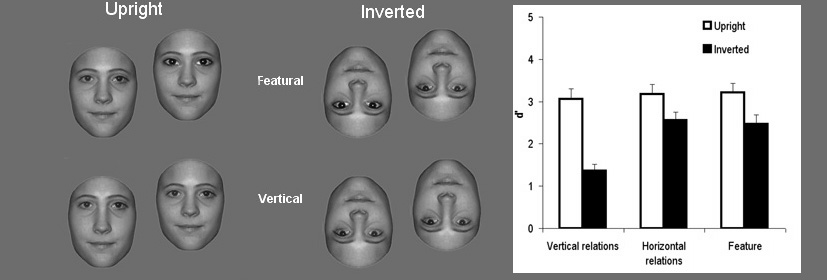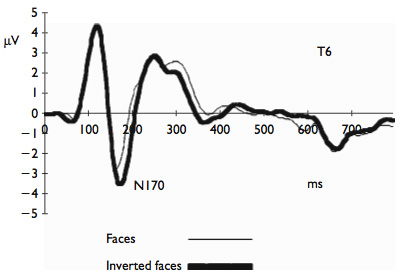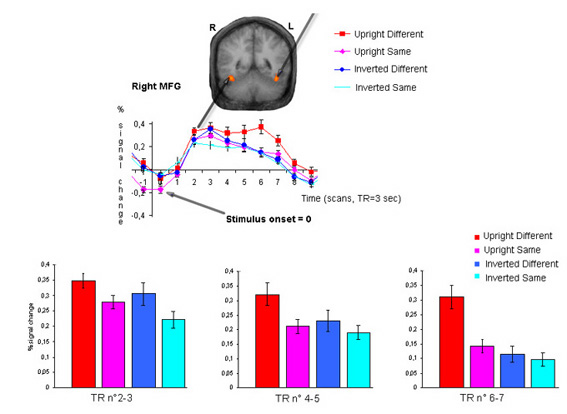Face inversion
General Description
It has long been known that presenting a face upside-down dramatically affects its recognition, but Yin (1969) was the first to show that inversion affects the recognition of faces more than for other object categories. Since then, researchers have conjectured about the sources of this 'face inversion effect'. While faces are recognized both on the basis of local features and their spatial relationships, there is a fairly large body of evidence that inversion affects more these spatial relationships, or face configuration (see our review on this issue: Rossion & Gauthier, 2002; as well as Maurer et al., 2002).
We have recenlty shown that while inversion affects equally well the processing of local features and of horizontal distances between features, the perception of vertical distances is spectacularly impaired (Goffaux & Rossion, 2007).

This does not appear to be related to the axis of rotation because vertical relationships are also more affected when faces are flipped horizontally (90 degrees).
In this line of research we have essentially investigated how inversion affected the early stages of face processing using ERPs.
In parallel with the findings of Yin, we have shown that inversion does not only increase and delay the N170 (Bentin et al., 1996; Rossion et al., 1999 - see related work on the N170), but that these effects are specific for faces or larger than for other objects (Rossion et al., 2000). In fact, the N170 delay can be found for pictures of highly familiar objects such as cars or words (Rossion et al., 2003) or the same novel objects after expertise training (Rossion et al., 2002; Busey & Vanderkolk, 2005), but it is larger for faces.

The fact that face inversion affects the N170 so strongly is indirect evidence that face configuration is extracted as early as 130 ms (onset of N170).
We have also studied face inversion in fMRI and shown that the source of the face inversion effect may lie in visual areas responding preferentially to faces ('FFA' and 'OFA'). We used an adaptation paradigm to show that there is larger adaptation (lower signal) in these areas when different facial identities are presented upside-down than when they are upright (Mazard et al., 2006). This differential adaptation rate accounts for a large part in the overall smaller response found in these regions for inverted faces.

Currently, we are running behavioural studies aimed at clarifying further the kind of spatial relationships are more impaired following upside-down face inversion. Our ERP experiments aim at clarifying the nature of amplitude and latency effects of inversion on the N170, something that has not been clarified yet in the literature.
Related Papers/Abstracts
Van Belle, G., de Graef, P., Verfaillie, K., Rossion, B., Lefèvre, P. (2010). Face inversion impairs holistic perception: Evidence from gaze-contingent stimulation. Journal of Vision. May 1;10. pii: 10.5.10. doi: 10.1167/10.5.10. [PDF]
Busigny, T. & Rossion, B. (2010). Acquired prosopagnosia abolishes the face inversion effect. Cortex, 46, 965-981. [PDF]
Rossion, B. & Curran, T. (2010). Visual expertise with pictures of cars correlates with RT magnitude of the car inversion effect. Perception, 39, 173-183. [PDF]
Rossion, B. (2009). Distinguishing the cause and consequence of face inversion: the perceptual field hypothesis. Acta Psychologica, 132, 300-312. [PDF]
Goffaux, V., Rossion, B., Sorger, B., Schiltz, C., Goebel, R. (2009). Face inversion disrupts the perception of vertical relations between features in the right human occipito-temporal cortex. Journal of Neuropsychology, 3, 45-67. [PDF]
Rossion, B. (2008). Picture-plane inversion leads to qualitative changes of face perception. Acta Psychologica, 128, 274-289. [PDF]
de Heering, A. & Rossion, B. (2008). Prolonged visual experience in adulthood modulates holistic face perception. PLOS One, 3(5):e2317. [PDF]
Jacques, C. & Rossion, B. (2007). Early electrophysiological responses to multiple face orientations correlate with individual discrimination performance in humans. NeuroImage, 36, 863-876. [PDF]
Jacques, C. d'Arripe, O., Rossion, B. (2007). The time course of the inversion effect during individual face discrimination. Journal of Vision, 7(8):3, 1-9, https://journalofvision.org/7/8/3/, doi:10.1167/7.8.3. [PDF]
Goffaux, V. & Rossion, B. (2007). Face inversion disproportionately impairs the perception of vertical but not horizontal relations between features. Journal of Experimental Psychology: Human Perception and Performance, 33, 995-1002. [PDF] [slideshow summary]
Mazard, A., Schiltz, C ., Rossion, B. (2006). Recovery from adaptation to facial identity is larger for upright than inverted faces in the human occipito-temporal cortex. Neuropsychologia, 44, 912-922. [PDF] [slideshow summary]
Rossion, B., Joyce, C.J., Cottrell, G.W., Tarr, M.J. (2003). Early lateralization and orientation tuning for face, word and object processing in the visual cortex. NeuroImage, 20, 1609-1624. [PDF]
Goffaux, V., Gauthier, I., Rossion, B. (2003). Spatial scale contribution to early visual differences between face and object processing. Cognitive Brain Research, 16, 416-424. [PDF]
Rossion, B., Curran, T., Gauthier, I. (2002). A defense of the subordinate-level expertise account for the N170 component. Cognition, 85, 189-196. [PDF]
Rossion, B., Gauthier, I., Goffaux, V., Tarr, M.-J., Crommelinck, M. (2002). Expertise training with novel objects leads to face-like electrophysiological responses. Psychological Science, 13, 250-257. [PDF]
Rossion, B. & Gauthier, I. (2002). How does the brain process upright and inverted faces? Behavioral and Cognitive Neuroscience Reviews, 1, 63-75. [PDF]
Rossion, B., Gauthier, I.,Tarr, M.J., Despland, P.-A., Linotte, S., Bruyer, R., Crommelinck, M. (2000). The N170 occipito-temporal component is enhanced and delayed to inverted faces but not to inverted objects: an electrophysiological account of face-specific processes in the human brain, Neuroreport, 11, 1-6. [PDF]
Rossion, B., Delvenne, J.-F., Debatisse, D., Goffaux, V., Bruyer, R., Crommelinck, M., Guérit, J.-M. (1999). Spatio-temporal brain localization of the face inversion effect, Biological Psychology, 50, 173-189. [PDF]




